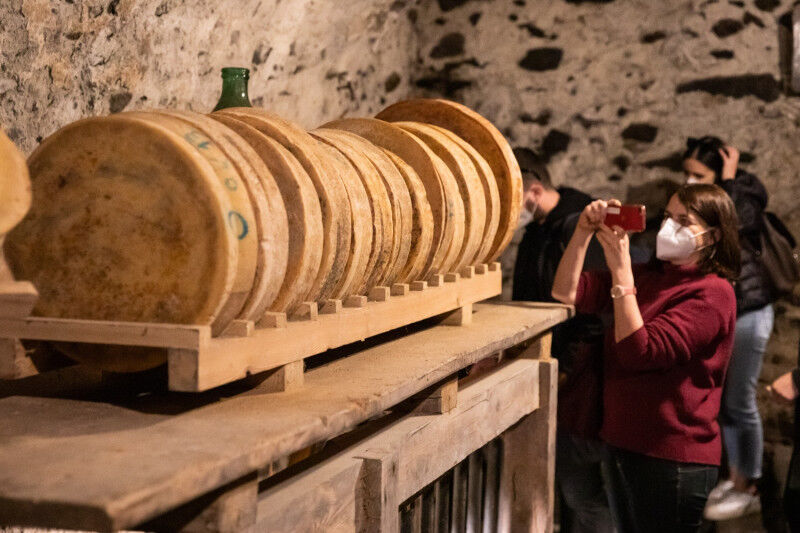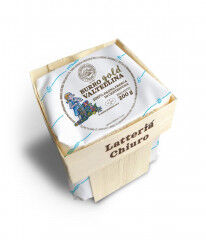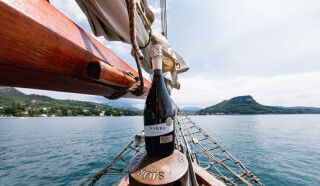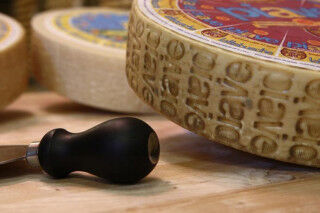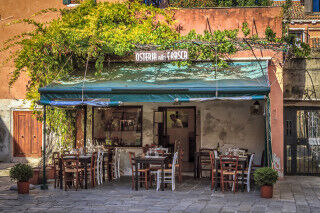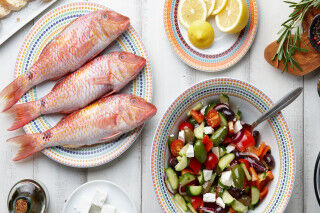Italy’s Northern Valtellina area, in the Lombardy valley area bordering on Switzerland, is for outdoors enthusiasts. This is a valley that asks you to walk it, to cycle it, to climb it, and then once your appetite is raring to go, to stop in its meadows to taste its salamis and local cheeses, and to drink its wine. What more could you ask for?!
In Italy, there are places that are more “outdoors-focused” than others. In the Valtellina area, we find an scintillating range of lands and natural features - we can run the gamut from Lake Como’s 200 meters sea level altitude, to Piz Bernina’s 4000 meters altitude - a huge range for just one region.
The Valtellina valley runs 200 kilometers from west to east, and creates its own unique, relatively mild microclimate. The Rhaetian Alps block the winds from the North, and the Orobic Alps (also knows as the Bergamo Alps) impede humidity coming in from the southern Po Valley.
The breezes off of Lake Como dry out the air. The area’s varied altitudes with ensuing thermal excursions are one of Valtellina’s great assets, and thanks to these variable environments, some of Italy’s most renowned wine and gourmet specialties are produced here.
While Lake Como is certainly a place we all know and love, Lake Garda is also not a place to be missed. Italy’s largest lake, the wines of area are superb - check out the Garda DOC Spumante selection, as well as a food-focused tour of Lake Garda’s culinary perspective.
In order to learn more about the Valtellina’s immense wealth of panoramas and tasty treats, we participated in a promotional tour, Taste the Alps, organized thanks to the participation of the Distretto Agroalimentare di Qualità della Valtellina.
During the experience, we were able to visit to actual production sites of these fabled cheese and salumi producers. What followed was even better: a tasting experience allowing us to better understand the area’s entire supply chain process. My report follows - get your taste bud ready!
BUCKWHEAT, I.E., GRANO SARACENO: VALTELLINA’S “WHEAT”
Kicking right off with an immediate distinction: Valtellina is the only place in Italy to claim a traditional dark wheat bread as a typical dish. Buckwheat is in fact the bread’s primary ingredient, but it might come as a surprise to know that buckwheat is not actually wheat! This herbaceous plant is transformed into buckwheat thanks to the unique grinding process the plant undergoes. This results in a gluten-free flour used in a wide range of various culinary uses.
The small city of Teglio is Lombardy’s capital of Buckwheat. If you visit during the month of May, you’ll be in for a treat: white flowering Buckwheat plants provide a perfect backdrop to your outdoor hiking experience.
Buckwheat was traditionally the ideal crop to harvest and cultivate in the area in summertime months, during the land’s fallow period after the winter harvest of rye, potatoes, and barley. As an added bonus, Buckwheat is also impervious to parasitical attacks, and thrives in colder climates.
Buckwheat has been cultivated this way since the 1600s, until producers deemed its production as overly labor intensive. Eventually, the slopes and terraces where Buckwheat had been planted made room to accommodate more profitable crops. The plots surviving today are few, and mainly concentrated between the towns of Teglio, Vervio, and Postalesio.
The grassroots Italian organization Slow Food, with their focus on the valorization of local food traditions, has included Buckwheat in its Ark of Taste, a catalogue of regional endangered heritage foods. Long considered an overly rustic ingredient, mainly thanks to its inclusion in a range of cucina povera dishes, buckwheat is actually at the heart of many local dishes that have since gained in reputation and fame. One of Valtellina’s most widespread and beloved dishes, “black polenta,” is in reality, a mix of buckwheat and corn flour.
When this base is mixed with butter and cheese, we know the entrée as “Polenta Taragna.” If cooked in fresh cream, we call it “Pulenta ’n Fiù,” or Polenta in fiore (Flowering Polenta). Valtellina’s street-food: Sciatt, buckwheat pancakes filled with local cheese varieties.
Hands’ down the recipe most associated with Valtellina is Pizzoccheri, fresh Tagliatelle made with buckwheat and wheat flours. The handmade pasta is then cooked with potatoes, cabbage or other local vegetables and then further dressed with melted butter and local cheese. Scimudin, Casera, or Bitto cheeses are perfect companions - we’ll dive into the Valtellina cheese in just a minute.
Another great option to taste is Chisciöl, a small focaccia made with Buckwheat flour, and filled with local Casera cheese and then typically slightly seasoned.
If all the food talk is making you hungry, check out the Recipe Index for lots of Italian recipe inspiration.
LET’S GET ON WITH THE TASTING
Our first stop is in Chiuro, a charming small town offering some of Valtellina’s finest wine and food traditions. That includes the Radaelli family, owners of the Ristorante San Carlo, a temple of Valtellina’s finest gourmet goodies, and in its 6th generation of existence.
If you love trying new flavors, I’d advise beginning with a tasty Salted Venison Carpaccio with Pistachios and Raspberries - this will help you begin to acclimato to mountain flavors and palates. Continue with Bresaola and Cheese bundles, to coddle your taste buds.
If a more traditional Carpaccio recipe is what you’re thinking about right, don’t miss our recipe for Beef Carpaccio - perfect for the warm summer months ahead.
Once you’ve enjoyed your fulfilling meal, be sure to ask for a cellar visit. This newly renovated cellar is a literal maze of winding, scenic tunnels dating all the way back to the 17th century. Here, you’ll find hundreds of different labels, both Italian and international selections. The restaurant also added a charming tasting room with soft, relaxing lighting and a vaulted stone roof.
VALTELLINA’S WHITE SIDE - MOUNTAIN MILK
The mountain is the literal provider of milk to this region. Local milk comes from the high altitude pastures where local herds graze. The milk produced locally is so genuine and so prized that a Ministerial Decree has applied the prestigious “Mountain Product” label to the product.
What makes the Valtellina milk so special? It starts from the local animals, creatures born and raised in the local Valtellina mountain areas. The cows are fed local forage exclusively.
Once poured into your glass, you’ll note the milk’s distinctive flavor, and while not immediately noticeable, the milk’s nutritional value is without parallel. Good fats, proteins and casein values are significantly higher compared to other milk sources.
Another element distinguishing the Valtellina milk sector is the strength of cooperation amongst its producers. Due to the area’s expansive and at times, inaccessible or fragmented areas, it becomes impossible to create an equal ratio of farmers to milk and cheese production facilities. This is where the area’s cooperative system shines.
The Latteria Sociale di Chiuro is one such example. Created in 1957, this Latteria is the first cooperative experiment in the Valtellina region. The Latteria Sociale was created as a reply to the need for an entrepreneurial dimension to the work many small local farmers were doing. Today, the Latteria has approximately 20 members between the Sondrio and Tirano provinces, with many of them operating on a strict organic-only approach.
The Latteria’s “outlet store” is a full-immersion experience into the world of fine dairy products. Love yogurt? Check out the Alpyò label, specializing in Valtellina-milk only fresh yogurt aromatized with hazelnuts, chestnuts or local jams from the Il Sentiero label. This cooperative is a socially-targeted project geared towards reintegrating disadvantaged people into the job market.
LIQUID TO SOLID: VALTELLINA’S CHEESES
A pastoral aroma is one of the main descriptors tasters note when enjoying local cheeses. Soft or very mature cheeses need to reflect herbaceous, fresh notes of local hay and wild flowers in order to reflect the local product’s typical features.
The Scimudin cheese meets these requirements with flying colors. This fresh selection, called an “entry cheese,” has an aging time of 10 days max. Beautifully ivory in color, the cheese is pillowy-soft, enveloping you in a welcoming milk flavor.
These entry-cheeses weigh maximum 1.5 kilos, and were once upon a time made exclusively from goat’s milk. Traditionally made exclusively in Bormio, today Scimud (local dialect for cheese) is crafted either entirely with cow’s milk, or a blend of cow and goat milk.
Casera DOP cheese represents a step up on the cheese ladder. This cheese is used widely to add flavor and enhance classic regional dishes like Sciatt and Pizzoccheri. This semi-lean cheese is enjoyed both aged and fresh. Crafted with only partially skim milk, the cheese hails from the larger city of Sondrio.
Casera is the winter cheese that locals enjoy during the absence of Bitto, an Alpine cheese produced traditionally only during the summer months. Today, Bitto is available throughout the year, and Casera is enjoyed alongside the Bitto cheeses. Both have the same origins, and share the same Consortium denomination. In appearance, they are similar as well, with both featuring a slightly concave heel.
How is Bitto made? Bitto cheese producers follow traditional methods, combining two or more different milks from separate milkings. The first milk used is collected and left to rest overnight. The morning after, the milk is skimmed, and blended with fresh milk left whole.
In order to be labelled with the sought-after DOP label, Bitto must be aged for at least 70 days. Where does this aging take place? In Casere, local Italian for cheese farms.
One of the best parts of a Casera tasting is to be able to include more aged selections, some aged for 300 days or more. While enjoying these selections, our approach to savoring changes, from a hastier intake to a more meditative approach. Cheese selections become flakier, spicier, fruitier.
Genuine Casera cheese is made exclusively from milk from the Alpine Brown Cow, a nearly-extinct cow breed that has now recuperated in numbers and can be found in various mountain areas. The breed is particularly prized for its elevated milk capacity.
While we can find Bitto DOP year-round today, its production location remains tied to tradition, and takes place exclusively in mountain pastures, where the herds graze in high pastures in the summertime. Bitto, or Bitu (Italian for perennial) is crafted following ancient Celtic traditions. Cow’s milk is collected and curdled directly onsite at high altitudes, and producers may add up to 10% of goat’s milk if they prefer.
Once curdling and processing has gotten underway, Bitto undergoes the maturation and aging process directly in pasture huts in the Alpine mountains.
Curious about Italian cheeses? Learn a bit more about a Tuscan cheesemaker, Andrea Magi, who is creating his own Tuscan dairy magic near Arezzo, in the heart of south-eastern Tuscany.
BITTO LIFE LESSONS (AND MORE CHEESES)
As indicated above, the maturation process for Bitto cheese begins high up in the Alpine mountains, in small huts. At a certain stage however, aging continues in specialized facilities down in the Valtellina valley. These spots are typically dairy farms, but the aging process can also be found underway in local restaurants, bodegas, and even hotels.
The best place to enjoy a Vertical Bitto tasting, of a tasting where several differently aged cheese are tasted, working your way up from 70 day-aged selections, is the Ciapponi gourmet shop.
Opened in 1883, Ciapponi can be found in the small town Morbegno, the Bitto town par excellence. Ciapponi is a temple of true Valtellina values: a visual delight of stone vaults, masonry columns, multi-level cellars that hold treasure-like collections of Bitto cheese rounds aged up to 10 years.
At Ciapponi, aging takes a very slow pace. If you’re looking for a more contemporary approach, look no further than the Latteria Sociale della Valtellina, located in the town of Delebio. This cooperative counts 110 members, and pulls in dairies ranging from the Val Furva area all the way southwest to Valchiavenna, including the towns of Lecco and Como, in the Lake Como area.
Members are smaller realities, with an average of 50 heads os cattle to each dairy farm.
The Latteria Sociale di Valtellina was born in 1969, and has consistently stayed true to its five founding principles: complete traceability, high-quality milk, internal pumping, animal welfare, and mountain products.
The Latteria is the largest Bitto refiner in the area, although at the Latteria “outlet” shop, you’ll find the entire range of speciality products, from milk to butter to soft cheese. These products are appreciated by home consumers as well as the great culinary chefs and masters who cook and create with this Valtellina cheese, including chef Andrea Berton and the Pasticceria Marchesi kitchens.
VALTELLINA’S BELOVED HEALTHY CURED MEAT: BRESAOLA IGP
The relationship between cured meats and diet is a curious one, but the Bresaola di Valtellina IGP is beloved by classic consumers and diet-conscious consumers as well. Its taste and low calorie content help immensely with this image.
Bresaola di Valtellina IGP is made from Italian and external beef cuts. Giving it that special taste is the local climate. Dry and windy, the conditions allow for minimal salt use during the preservation phase of the cold cut. Meat used must be soft, with a barely noticeable fat marbling. Seasoning of Valtellina Bresaola is quite brief, lasting on average between 30-60 days.
In selecting the beef used for Bresaola di Valtellina, 5 individual muscle cuts have been identified: hip rounds, beef shoulder, beef topside, beef flank, and upper thigh. Meat must come from cows older than 18 months, but younger than 4 years of age. The ideal cow is one raised in outdoor pastures, and fed only with select forage.
A hot Bresaola topic is beef used from overseas, particularly from the Zebu cattle breed. Paola Dolzadelli, Main Coordinator of the Consortium of Bresaola di Valtellina IGP, addresses this topic, saying “Certification of a Bresaola type indicates the special ability and specialization that Valtellina-area artisans possess and express when transforming the meat into the charcuterie in question.
This ability is more indicative of what makes the Valtellina Bresaola so unique. What matters today is the quality of the meat used, not its geographic origins. Today, much of the raw beef used to create Bresaola comes from the EU and South America.”
Bresaola IGP di Valtellina continues to be mainly consumed in Italy, with a very low percentage dedicated to exportation. During Covid, national Bresaola sales have decreased, but the cured meat continues to be one of the figurehead products of the Valtellina area.
A DOXA survey of 1000 residents between 18 and 84 years of age proves that Bresaola della Valtellina IGP is the most notable local product, recognized by 8 our of 10 survey respondents. Valtellina Bresaola was identified by 78% of respondents as being Valtellina’s best known gourmet product, followed by Pizzoccheri’s 64%, Valtellina Apple’s 58%, and Valtellina wine’s 47%.
The DOXA survey also demonstrated that at least 6 out of 10 Italians have visited the Valtellina area once in the past. The most recent tourist boom from the past recent years proves this travel trend to be accurate.
With travel on the mind, the Bresaola Destination board has introduced a new travel and food idea perfect for Valtellina: 10 local sandwich varieties all made with Bresaola, and all identified with 10 different tourist trekking paths in the area. Head over to the Valtellina tourism platform, and look up Destinazione Bresaola for further details.
FINE FOOD AND AL FRESCO DINING
The small town of Masino, located close to the Adda River, we can find the Le Case dei Baff farmhouse and restaurant. Managed and run by the Cerasa family, 20 years of experience result in truly local, farm-to-table culinary approaches.
The farm makes good use of local cheese, meat, vegetables, fruits, and wines that all come from the areas surrounding the farmhouse. In case you want to stay on-site, the farmhouse also has several rooms available for your stay.
The farm also has an on-site kitchen facility, and a restaurant functioning for nearly a century. Baff also produces their own Bresaola blend, apprised for its particularly tasty, soft, slightly spicy aroma and very lean composition.
If you love exploring Italian culinary areas, check out the food-focused specialties in the Emilia-Romagna area - more deliciousness awaits!
FRUITY AND FIERCE: VALTELLINA APPLES
The perfect way to end a meal, or to snack between lunch and dinner is an apple. The Valtellina apples are an actual IGP brand, and are known for their freshness, aromatics, and crisp textures.
The dry climate, along with the area’s high latitude and altitude help create the perfect growing environment for the Valtellina apples to thrive. The significant temperature ranges found here also assist with the Valtellina apples’ development into a fine, enjoyable fruit Italians snap up.
The most common apple types are Stark Delicious, Golden Delicious, Gala and Fuji. The apples themselves are but one stop on the traditional product horizon, and Melavi knows just how many apple-based products local producers create with these wonderful ingredients.
Melavi is a cooperative organization with 300 members, and is also responsible for harvesting over 20,000 tons of Valtellina apples in peak season, between August - mid-October.
Crafting apple-based nectars and juices, in both pure and blended versions, Melavi is a world that takes on many different forms and specialties. Their latest apple project us Rockit, a miniature apple. A patent filed in New Zealand is at the heart of the Rockit, which is a perfect snack when you’re far from home. Kids also love Rockits, which make for ideal, healthy snacks.
Small, tasty, crunchy, with beautiful streaks of yellow and red. We can call it miniature, but that nickname derives solely from its size, not its flavor and impact, which are anything but miniature.
Don't forget to register for Mamablip's weekly newsletter for updates on all the exciting newest Mamablip Blog articles, recipes and other wine news from Italy.
